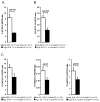Comparison of free serum oxylipin concentrations in hyper- vs. normolipidemic men
- PMID: 23694766
- PMCID: PMC4057063
- DOI: 10.1016/j.plefa.2013.04.001
Comparison of free serum oxylipin concentrations in hyper- vs. normolipidemic men
Abstract
Oxylipins, the oxidation products of unsaturated fatty acids (FA), are potent endogenous mediators being involved in the regulation of various biological processes such as inflammation, pain and blood coagulation. Compared to oxylipins derived from arachidonic acid (AA) by cyclooxygenase action, i.e. prostanoides, only limited information is available about the endogenous levels of hydroxy-, epoxy- and dihydroxy-FA of linoleic acid (LA), AA, α-linolenic acid (ALA), eicosapentaenoic acid (EPA) and docosahexaenoic acid (DHA) in humans. Particularly, it is unknown how metabolic disorders affect endogenous oxylipin levels in humans. Therefore, in the present study we compared the serum concentrations of 44 oxylipins in 20 normolipidemic with 20 hyperlipidemic (total cholesterol >200 mg/dl; LDL-C>130 mg/dl; TG>150 mg/dl) men (age 29-51 y). The serum concentration varied strongly among subjects. For most hydroxy-, epoxy- and dihydroxy-FA the concentrations were comparable to those in plasma reported in earlier studies. Despite the significant change in blood lipid levels the hyperlipidemic group showed only minor differences in oxylipin levels. The hyperlipidemic subjects had a slightly higher serum concentration of 8,9-DiHETrE, 5-HEPE, 10,11-DiHDPE, and a lower concentration of 12,13-DiHOME, 12-HETE, 9,10-DiHODE, and 12,13-DiHODE compared to normolipidemic subjects. Overall the hydroxy-, epoxy- and dihydroxy-FA levels were not changed suggesting that mild combined hyperlipidemia has no apparent effect on the concentration of circulating oxylipins. By contrast, serum levels of several hydroxy-, epoxy-, and dihydroxy-FA are dependent on the individual status of the parent FA. Particularly, a strong correlation between the EPA content in the erythrocyte membrane and the serum concentration of EPA derived oxylipins was observed. Given that the synthesis of EPA from other n-3 FA in humans is low; this suggests that oxylipin levels can be directly influenced by the diet.
Copyright © 2013 Elsevier Ltd. All rights reserved.
Figures




Similar articles
-
Modulation of blood oxylipin levels by long-chain omega-3 fatty acid supplementation in hyper- and normolipidemic men.Prostaglandins Leukot Essent Fatty Acids. 2014 Feb-Mar;90(2-3):27-37. doi: 10.1016/j.plefa.2013.12.008. Epub 2013 Dec 27. Prostaglandins Leukot Essent Fatty Acids. 2014. PMID: 24411718 Free PMC article. Clinical Trial.
-
Effects of a 12-week high-α-linolenic acid intervention on EPA and DHA concentrations in red blood cells and plasma oxylipin pattern in subjects with a low EPA and DHA status.Food Funct. 2018 Mar 1;9(3):1587-1600. doi: 10.1039/c7fo01809f. Epub 2018 Feb 20. Food Funct. 2018. PMID: 29459911 Clinical Trial.
-
Effect of DHA supplementation on oxylipin levels in plasma and immune cell stimulated blood.Prostaglandins Leukot Essent Fatty Acids. 2017 Jun;121:76-87. doi: 10.1016/j.plefa.2017.06.007. Epub 2017 Jun 15. Prostaglandins Leukot Essent Fatty Acids. 2017. PMID: 28651702 Clinical Trial.
-
Effects of omega-3 fatty acid supplementation on the pattern of oxylipins: a short review about the modulation of hydroxy-, dihydroxy-, and epoxy-fatty acids.Food Funct. 2017 Jul 19;8(7):2355-2367. doi: 10.1039/c7fo00403f. Food Funct. 2017. PMID: 28682409 Review.
-
The Role of α-Linolenic Acid and Its Oxylipins in Human Cardiovascular Diseases.Int J Mol Sci. 2023 Mar 24;24(7):6110. doi: 10.3390/ijms24076110. Int J Mol Sci. 2023. PMID: 37047085 Free PMC article. Review.
Cited by
-
Intimal smooth muscle cells are a source but not a sensor of anti-inflammatory CYP450 derived oxylipins.Biochem Biophys Res Commun. 2015 Aug 7;463(4):774-80. doi: 10.1016/j.bbrc.2015.06.012. Epub 2015 Jun 15. Biochem Biophys Res Commun. 2015. PMID: 26086108 Free PMC article.
-
The Regulation of Lipokines by Environmental Factors.Nutrients. 2019 Oct 11;11(10):2422. doi: 10.3390/nu11102422. Nutrients. 2019. PMID: 31614481 Free PMC article. Review.
-
High dietary arachidonic acid levels induce changes in complex lipids and immune-related eicosanoids and increase levels of oxidised metabolites in zebrafish (Danio rerio).Br J Nutr. 2017 Apr;117(8):1075-1085. doi: 10.1017/S0007114517000903. Epub 2017 May 9. Br J Nutr. 2017. PMID: 28485254 Free PMC article.
-
Nrf2 Activation by 5-lipoxygenase Metabolites in Human Umbilical Vascular Endothelial Cells.Nutrients. 2017 Sep 11;9(9):1001. doi: 10.3390/nu9091001. Nutrients. 2017. PMID: 28892009 Free PMC article.
-
Regulation of rat plasma and cerebral cortex oxylipin concentrations with increasing levels of dietary linoleic acid.Prostaglandins Leukot Essent Fatty Acids. 2018 Nov;138:71-80. doi: 10.1016/j.plefa.2016.05.004. Epub 2016 May 11. Prostaglandins Leukot Essent Fatty Acids. 2018. PMID: 27282298 Free PMC article.
References
-
- Burdge GC, Calder PC. Conversion of alpha-linolenic acid to longer-chain polyunsaturated fatty acids in human adults. Reproduction, nutrition, development. 2005;45:581–597. - PubMed
-
- Whelan J. The health implications of changing linoleic acid intakes. Prostag Leukotr Ess. 2008;79:165–167. - PubMed
-
- Brenna JT, Salem N, Jr, Sinclair AJ, Cunnane SC. alpha-Linolenic acid supplementation and conversion to n-3 long-chain polyunsaturated fatty acids in humans. Prostaglandins, leukotrienes and essential fatty acids. 2009;80:85–91. - PubMed
-
- Plourde M, Cunnane SC. Extremely limited synthesis of long chain polyunsaturates in adults: implications for their dietary essentiality and use as supplements, Applied physiology, nutrition, and metabolism = Physiologie appliquee, nutrition et metabolisme. 2007;32:619–634. - PubMed
-
- Cabo J, Alonso R, Mata P. Omega-3 fatty acids and blood pressure. Br J Nutr. 2012;107(Suppl 2):S195–200. - PubMed
Publication types
MeSH terms
Substances
Grants and funding
LinkOut - more resources
Full Text Sources
Other Literature Sources
Medical
Research Materials
Miscellaneous

